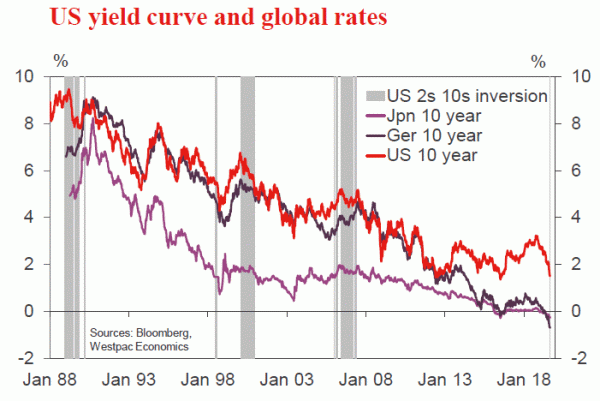The addition of two cuts in 2020 following Sep,Oct and Dec decisions will leave the fed funds rate at 0.875%
On August 2, we revised our forecast for the US federal funds rate to include a series of 0.25% rate cuts in September, October and December 2019. That replaced our earlier view that, as Chairman Powell noted in July, the rate cut cycle that began in July would be a “mid-cycle adjustment” rather than the beginning of a sustained rate cut cycle.
The development that changed our minds was “President Trump’s decision to impose a new 10% tariff on the circa $300bn of Chinese imports to the US which had previously been unaffected by the trade war”.
The decision had two key implications: the $300bn of goods so far unaffected are primarily direct consumer goods, indicating an unexpected negative shock to household budgets. Secondly, the development significantly raised the intensity of the trade war with negative implications for world growth, global manufacturing and business investment (including in the US).
We concluded that, “These developments will make significant changes to the FOMC’s assessment of the outlook and associated risks, particularly given US growth was already slowing.”
Since then, we have seen further adjustments to trade policy. The implementation of the new tariff on circa $300 billion of primarily consumer goods has been staggered ($120 billion in September and the remainder in December), but the rate has been increased to 15%. The tariff on the goods which had earlier been taxed has also been raised from 25% to 30%, effective October 1.
This represents an intensifying of the trade tensions and a further challenge to the US consumer.
As we peruse 2020, it is the consumer who will represent the most concern for growth. Following such a long period of abnormally strong employment growth and rising real wages growth, household income growth and sentiment is subject to a cyclical moderation – even in the absence of the global shock. Given the importance of consumption to GDP (a weight of 70%), such an outcome seems likely to push growth below trend.
The reality however is that a direct shock to US household incomes and sentiment from global uncertainties is increasingly becoming a base-case proposition. Albeit not to the same scale as business investment, employment growth has slowed materially in 2019. At July, average monthly nonfarm payrolls growth for 2019 stood at 165k, down from 223k in 2018. Ahead, the ISMs point to a further slowing in employment growth, we believe back towards 100k by year end and below that level in 2020. If this trend is seen, then through 2020 the unemployment rate will begin to rise – giving employers further justification to hold back on wage increases, assess staffing levels and slow household income growth.
Our base case for 2020 is now therefore that consumer growth will slow below trend. The risks here are also skewed to the downside. This is largely because US firms have a history of rapidly reducing labour costs when their profits are threatened, but also as global uncertainties have become open ended.
In recent months, the FOMC have made clear that risk management is a primary focus of their policy decisions as they attempt to preserve this mature economic expansion.
This supports our current view that the FOMC will act at every meeting this year and, based on our forecast of persistently below trend growth in 2020, makes the case for the cuts to extend into 2020.
This case is strengthened by our expectation of no resolution to US/China trade tensions and other global uncertainties. Even if, due to political expediencies in an election year, the Administration cobbles together a “cosmetic” settlement, businesses will remain cautious and continue to trim risks.
On the basis of this outlook, we now expect cuts in the federal funds rate to extend into March and June 2020 leading to a “terminal” rate of 0.875%.
This does not represent a recessionary policy setting. Figure 1 highlights that those periods of inverse yield curves that correctly heralded a recession were at times of relatively high German and Japanese bond rates rather than the negative bond rates we have today. The sheer attraction of interest rate differentials has been flattening the US yield curve rather than signalling a recessionary outlook for the US economy.
If we were anticipating a recession in the US we would be forecasting a zero federal funds rate.
Our “terminal” federal funds rate of 0.875% is broadly in line with market pricing (currently 0.95%) and around 65 basis points below current bond rates. This curve has the scope to flatten further to around 50 basis points, but a significant further fall in US bond rates is unlikely to be justified unless the US economy does fall into recession with an associated zero federal funds rate.
Looking forward and noting our current forecasts of two more rate cuts from the RBA in October and February, we are now anticipating a narrowing of the RBA cash /federal funds rate differential of 75 basis points. However, as noted, this relative pricing is already anticipated by markets.
Given our core view that at times of global uncertainty ”risk off” or “safe haven” currencies like the US dollar, Japanese Yen, and Swiss Franc are favoured we are still not changing our central outlook that the AUD is likely to trend down to USD0.66 by the first half of 2020 and hold near that level through 2020.














